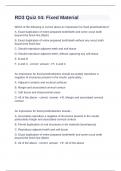RD3 Quiz #4: Fixed Material
Which of the following is correct about an impression for fixed prosthodontics?
A. Exact duplication of entire prepared tooth/teeth and some uncut tooth
beyond the finish line (flash)
B. Exact duplication of entire prepared tooth/teeth without any uncut tooth
beyond the finish line
C. Should reproduce adjacent teeth and soft tissue
D. Should reproduce adjacent teeth, without capturing any soft tissue
E. B and D
F. A and C - correct answer ✔F. A and C
An impression for fixed prosthodontics should accurately reproduce a
negative of structures present in the mouth, particularly...
A. Adjacent contacts and occlusal surfaces
B. Margin and associated cervical contour
C. Soft tissue and interproximal areas
D. All of the above - correct answer ✔B. Margin and associated cervical
contour
An impression for fixed prosthodontics should...
A. Accurately reproduce a negative of structures present in the mouth,
particularly margin and associated cervical contour
B. Permit duplication of oral structures in die material (stone/epoxy)
C. Reproduce adjacent teeth and soft tissue
D. Exact duplication of entire prepared tooth/teeth and some uncut tooth
beyond the finish line (flash)
E. All of the above - correct answer ✔E. All of the above
,Rigid impression materials for fixed prosthodontics include:
1. Dental compound
2. Impression plaster
3. Zinc Oxide Eugenol
4. Alginate (irreversible hydrocolloid)
5. Polyether Rubber
A. 1, 2, 3, and 4
B. 1, 2, 3, and 5
C. 4 and 5
D. 1, 2 and 3
E. All of the above - correct answer ✔D. 1, 2 and 3
Flexible impression materials for fixed prosthodontics include both aqueous
and non-aqueous elastomers. Which of the following are classified as non-
aqueous elastomers?
1. Polysulfide Rubber
2. Polyether Rubber
3. Alginate (irreversible hydrocolloid)
4. Agar (reversible hydrocolloid)
5. Addition silicone
A. 1, 2, 3, and 4
B. 4 and 5 only
C. 1, 2, and 3
D. 3 and 4 only
,E. All of the above - correct answer ✔D. 3 and 4 only
Flexible impression materials for fixed prosthodontics include both aqueous
and non-aqueous elastomers. Which of the following are classified as
aqueous elastomers?
1. Polysulfide Rubber
2. Polyether Rubber
3. Alginate (irreversible hydrocolloid)
4. Agar (reversible hydrocolloid)
5. Addition silicone
6. Condensation silicone
A. 1, 2, 3, and 4
B. 1, 2, 5, and 6
C. 1, 2, 3 and 6
D. 5 and 6 only
E. All of the above - correct answer ✔B. 1, 2, 5, and 6
Which of the following is an indication for Polyether Rubber (non-aqueous
elastomer)?
1. Complete dentures
2. Removable partial dentures
3. Single-unit fixed
4. Multiple-unit fixed
5. Implant restorations
A. 2, 3, and 5
, B. 1 and 2 only
C. 1, 2, 4, and 5
D. 1, 2, and 3
E. All of the above - correct answer ✔E. All of the above
Which of the following is an indication for Addition Silicone (non-aqueous
elastomer)?
1. Complete dentures
2. Removable partial dentures
3. Single-unit fixed
4. Multiple-unit fixed
5. Implant restorations
A. 2, 3, and 5
B. 1 and 2 only
C. 1, 2, 4, and 5
D. 1, 2, and 3
E. All of the above - correct answer ✔E. All of the above
Which of the following is an indication for Polysulfide Rubber (non-aqueous
elastomer)?
1. Complete dentures
2. Removable partial dentures
3. Single-unit fixed
4. Multiple-unit fixed
5. Implant restorations




